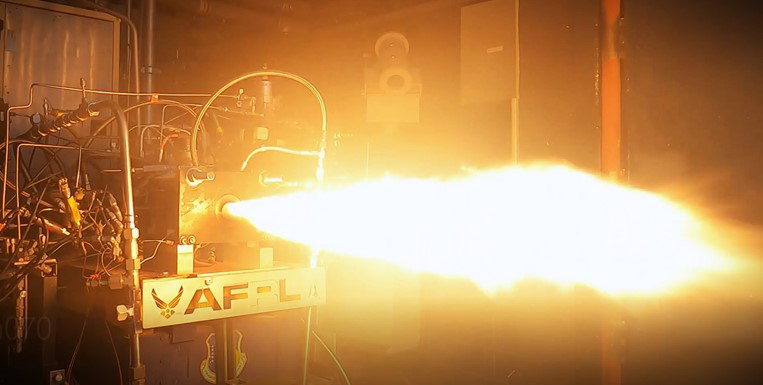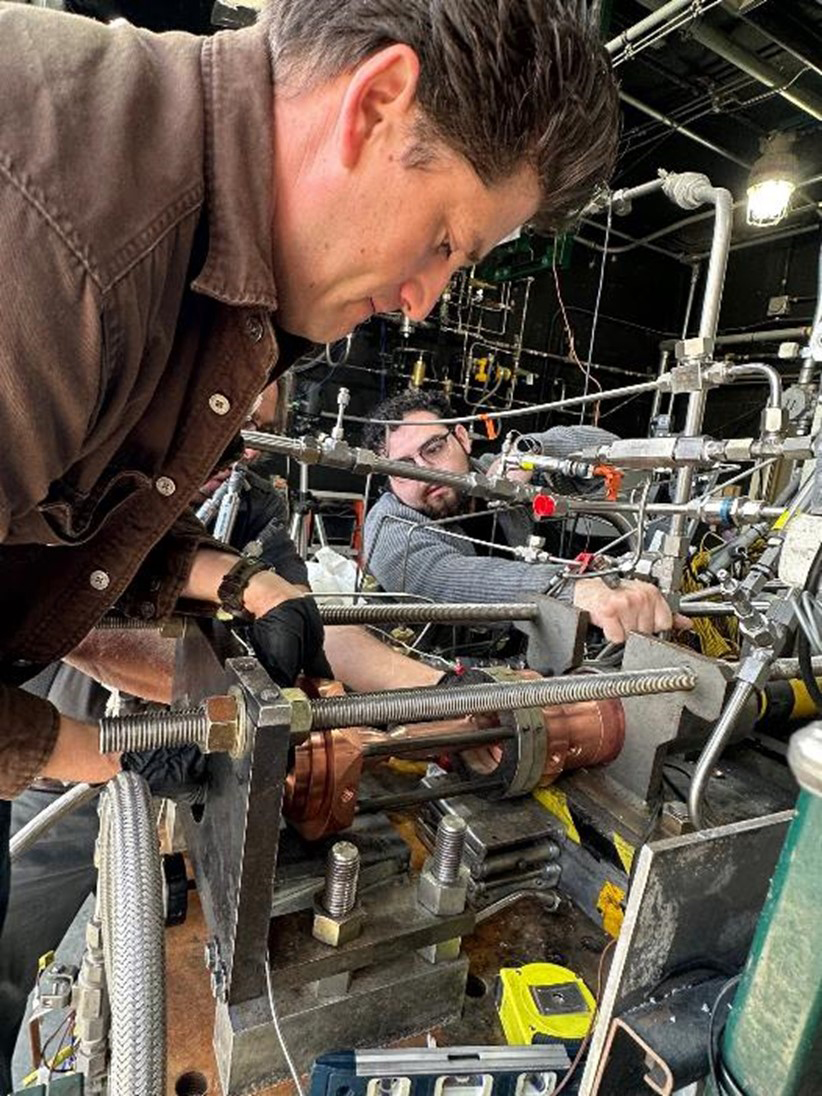AFRL researchers pave the way to lighter, faster additively manufactured rocket engines
EDWARDS AIR FORCE BASE, Calif. (AFRL) – The Air Force Research Laboratory, or AFRL, Rocket Propulsion Division, recently designed, printed, built and hot fired a first-ever, single-block rocket-engine thrust chamber additively manufactured using a process called laser powder directed energy deposition, or DED.
“AFRL’s investments in early advanced manufacturing techniques enable us to exploit corners of the design space for rocket engines and enable faster design turnover cycles from a concept in a whiteboard to test & evaluation in the field,” said Dr. Javier Urzay, chief Combustion Devices Branch.

The Air Force Research Laboratory, or AFRL, Rocket Propulsion Division, recently designed, printed, built and hot fired a first-ever, single-block rocket-engine thrust chamber additively manufactured using a process called laser powder directed energy deposition, or DED. DED is an additive manufacturing process in which the device injects metal powder into focused beams of high-power laser in highly controlled atmospheric conditions. The Hotfire of the thrust chamber is shown in the Experimental Cell 1 (EC-1) at the AFRL Rocket Lab. (U.S. Air Force photo)
DED is an additive manufacturing process in which the device injects metal powder into focused beams of high-power laser in highly controlled atmospheric conditions. “It provides the largest build box volume for thruster hardware to date, capable of printing seven-foot-tall parts. This build box volume is much larger than that obtainable with techniques like the laser powder bed fusion, or LPBF, process. In addition, DED enables an order of magnitude less investment in powder and less material waste. Engineers can also realize alloy blending and transitions in real time for multi-alloy builds to exploit the strength, weight and performance gains of next-generation superalloys,” said Urzay.
“These unique capabilities allow us to tackle complex engine designs requiring fewer iterations and leveraging shape optimization, lightweight materials, advanced metal alloys and composites, and rapid manufacturing,” Urzay said.
The AFRL Rocket Propulsion Division, a component of the Aerospace Systems Directorate, is working alongside the U.S. space industry to embed these advanced additive manufacturing processes into robust digital engineering environments.
Additive manufacturing works closely with the transition from traditional ways of manufacturing rocket engine hardware to automated manufacturing processes fed by digital environments involving artificial intelligence, machine learning, digital twins, 3D volumetric scanners and computer aided design, or CAD.
The multifaceted nature of the digital environment is necessary to manage the printers that produce lightweight thrust chambers, manifolds, injectors, pressure vessels, valves and turbomachinery blades with 3D shapes and internal features that are not easily achievable using traditional methods.
“While additive manufacturing offers many opportunities for accelerated production at lower costs, several challenges remain in the way of making this technology widely adopted by the rocket-propulsion industry and government laboratories,” said Edgar Felix, aerospace engineer at the Combustion Devices Branch.
AFRL is addressing the unique challenges of producing materials that can withstand the harsh environments in which rocket engines must perform.

Edgar Felix, Lead Investigator, front and Isaiah Jaramillo, Mechanical Specialist, work on the first-ever, single-block rocket-engine thrust chamber additively manufactured using a process called laser powder directed energy deposition, or DED. DED is an additive manufacturing process in which the device injects metal powder into focused beams of high-power laser in highly controlled atmospheric conditions (U.S. Air Force photo)
AFRL experts combine decades of rocket combustion chamber experience with insights into the challenges and opportunities of these new manufacturing techniques and maintain close collaborations with several external organizations that bring unique skills to the table.
“This latest breakthrough in additive manufacturing for rocket engines in our branch is one in a series that has been made possible only by forging long-lasting relationships across multiple industrial partners and government organizations, including the AFRL Materials and Manufacturing Directorate and NASA Marshall Space Flight Center,” Urzay said. “Their work is extremely valuable for the nation, and together we are an unstoppable team.”
The AFRL Rocket Propulsion Division continues to work on novel techniques for additive manufacturing with the goal of surging capacity in both liquid rocket engines and solid rocket motors.
About AFRL
The Air Force Research Laboratory is the primary scientific research and development center for the Department of the Air Force. AFRL plays an integral role in leading the discovery, development, and integration of affordable warfighting technologies for our air, space and cyberspace force. With a workforce of more than 12,500 across nine technology areas and 40 other operations across the globe, AFRL provides a diverse portfolio of science and technology ranging from fundamental to advanced research and technology development. For more information, visit: www.afresearchlab.com.
